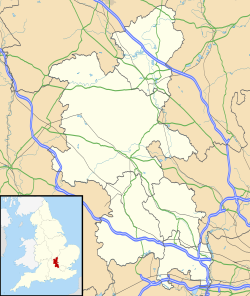St Michael and All Angels Church, Hughenden
| St Michael and All Angels, Hughenden | |
|---|---|

St Michael and All Angels Parish Church
|
|
| 51°39′6.45″N 0°45′9.36″W / 51.6517917°N 0.7526000°WCoordinates: 51°39′6.45″N 0°45′9.36″W / 51.6517917°N 0.7526000°W | |
| Location | Hughenden Valley, Buckinghamshire |
| Country | United Kingdom |
| Denomination | Church of England |
| Website | www |
| History | |
| Founded | c. 1100–1135 |
| Founder(s) | Geoffrey de Clinton |
| Associated people |
Benjamin Disraeli, member 1848–1881 Church restored 1874 and 1890 by Sir Arthur William Blomfield |
| Architecture | |
| Status | Parish church |
| Heritage designation | Listed Grade: II* |
| Style | Early English, extended Victorian Gothic |
| Administration | |
| Deanery | Wycombe |
| Archdeaconry | Buckingham |
| Diocese | Oxford |
| Province | Canterbury |
St Michael and All Angels Church is a Grade: II* listedAnglican church in the Hughenden Valley, Buckinghamshire, England, near to High Wycombe. It is closely associated with the nearby Hughenden Manor and the former Prime Minister of the United Kingdom, Benjamin Disraeli who is buried in the churchyard.
The church stands in land owned by the National Trust but the church and churchyard belong to the Church of England.
According to early records, a church existed on this site in the 12th century, built by Geoffrey de Clinton between 1100 and 1135. Monks established a small priory here in the building which is today used as a parish hall, Church House. The church itself is mediaeval in origin and this original building now forms the chancel and north chapel of the present building.
In 1848 Benjamin Disraeli purchased Hughenden Manor. The church was restored and extended between 1874 and 1890. Disraeli was British Prime Minister twice, in 1868 and 1874–80, and was made Earl of Beaconsfield in 1876. He died in 1881 and was buried in the family vault along with his wife Lady Beaconsfield (died 1872) which is located at the west wall of the church. Royal protocol did not permit Queen Victoria to attend the private funeral, but she visited the tomb a few days later to pay her respects.
The exterior walls of St Michael and All Angels are of flint with stone dressings and the roofs are tiled.
The oldest part of the church is the chancel, which was formed from the original mediaeval body of the church. When the church extension work was carried out, the floor was covered with ceramic tiles designed by Edward William Godwin and the walls decorated with 1881 wall paintings in the Aesthetic Movement style by Heaton, Butler and Bayne that depict the Nativity, the Four Evangelists and the Prophets.
...
Wikipedia

